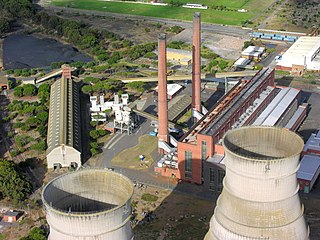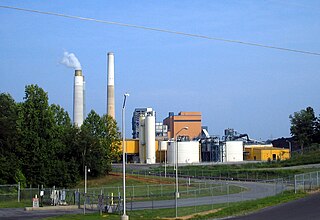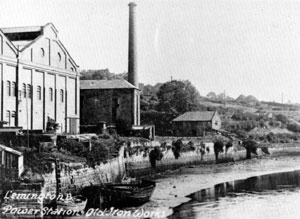
George Westinghouse Jr. was an American entrepreneur and engineer based in Pennsylvania who created the railway air brake and was a pioneer of the electrical industry, receiving his first patent at the age of 19. Westinghouse saw the potential of using alternating current for electric power distribution in the early 1880s and put all his resources into developing and marketing it. This put Westinghouse's business in direct competition with Thomas Edison, who marketed direct current for electric power distribution. In 1911 Westinghouse received the American Institute of Electrical Engineers's (AIEE) Edison Medal "For meritorious achievement in connection with the development of the alternating current system." He founded the Westinghouse Electric Corporation in 1886.

A power station, also referred to as a power plant and sometimes generating station or generating plant, is an industrial facility for the generation of electric power. Power stations are generally connected to an electrical grid.

The Westinghouse Electric Corporation was an American manufacturing company founded in 1886 by George Westinghouse. It was originally named "Westinghouse Electric & Manufacturing Company" and was renamed "Westinghouse Electric Corporation" in 1945. The company acquired the CBS television network in 1995 and was renamed "CBS Corporation" until being acquired by Viacom in 1999, a merger completed in April 2000. The CBS Corporation name was later reused for one of the two companies resulting from the split of Viacom in 2006.
Electrification is the process of powering by electricity and, in many contexts, the introduction of such power by changing over from an earlier power source.

The Shippingport Atomic Power Station was the world's first full-scale atomic electric power plant devoted exclusively to peacetime uses. It was located near the present-day Beaver Valley Nuclear Generating Station on the Ohio River in Beaver County, Pennsylvania, United States, about 25 miles (40 km) from Pittsburgh.
Combustion Engineering (C-E) was a multi-national American-based engineering firm that developed nuclear steam supply power systems in the United States. Originally headquartered in New York City, C-E moved its corporate offices to Stamford, Connecticut in 1973. C-E owned over three dozen other companies including Lummus Company, National Tank Company and the Morgan Door Company. The company was acquired by Asea Brown Boveri in early 1990. The boiler and fossil fuel businesses were purchased by Alstom in 2000, and the nuclear business was purchased by Westinghouse Electric Company also in 2000.

A thermal power station is a type of power station in which heat energy is converted to electrical energy. In a steam-generating cycle heat is used to boil water in a large pressure vessel to produce high-pressure steam, which drives a steam turbine connected to an electrical generator. The low-pressure exhaust from the turbine enters a steam condenser where it is cooled to produce hot condensate which is recycled to the heating process to generate more high pressure steam. This is known as a Rankine cycle.

The Hartford Electric Light Company (HELCO) is a defunct electrical company that was located on Pearl Street in Hartford, Connecticut. HELCO merged with the Connecticut Power Company in 1958. These merged with the Connecticut Light and Power Company (CL&P) and the Western Massachusetts Electric Company (WMECO) in 1966 to form Northeast Utilities (NU). Its former corporate headquarters building and main facility are in the Ann Street Historic District.

The Fisk Generating Station, also known as Fisk Street Generating Station or Fisk Station is an inactive medium-size, coal-fired electric generating station located at 1111 West Cermak Road in the Pilsen neighborhood of Chicago, Illinois. It was sited near the south branch of the Chicago River to provide access to water for steam and barge traffic for coal, and closed down in 2012.

Belews Creek Steam Station is a 2.24-GW, two-unit coal-fired generating facility located on Belews Lake in Stokes County, North Carolina. It is Duke Energy’s largest coal-burning power plant in the Carolinas and consistently ranks among the most efficient coal facilities in the United States. During 2006, it was the fifth most efficient coal power plant in the United States with a heat rate of 9,023 Btu/kWh. The remaining 62.2% of energy released by the burning coal is in the form of heat. It is dumped into Belews Lake, a man-made lake created by Duke Power for cooling water purposes in the early 1970s. In 2008, it was the #1 most efficient coal power plant in the United States with a heat rate of 9,204 British thermal units per kilowatt-hour (2.697 kWh/kWh) or 37.1% conversion efficiency.

Hawaiian Electric Industries, Inc. is the largest supplier of electricity in the state of Hawaii, supplying power to 95% of Hawaii's population through its electric utilities: Hawaiian Electric Company, Inc., Hawai'i Electric Light Company, Inc. and Maui Electric Company, Limited. In addition, HEI owns a financial institution serving Hawaii, American Savings Bank, and a clean energy and sustainability company, Pacific Current LLC.
The Westinghouse Combustion Turbine Systems Division (CTSD), part of Westinghouse Electric Corporation's Westinghouse Power Generation group, was originally located, along with the Steam Turbine Division (STD), in a major industrial manufacturing complex, referred to as the South Philadelphia Works, in Lester, PA near to the Philadelphia International Airport.

Lemington Power Station was a small, now demolished coal-fired power station, located in North East England. It was situated on the Lemington Gut, a backwater of the River Tyne, at Lemington, 3.5 mi (5.6 km) west of Newcastle upon Tyne. The station's main building stood until 2017 as a rare example of an early power station, dating from before the nationalisation of the United Kingdom's electrical supply industry.

Shoreham Power Station is a 420MWe combined cycle gas-fired power station in Southwick, West Sussex. It was built on the site of the Brighton B Power Station.

The Gould Street Generating Station was a former 100 MW electric generating plant operated by Exelon that was located on Gould Street in south Baltimore, Maryland, USA. The plant was adjacent to an elevated section of freeway I-95 and was south of the Riverside neighborhood and west of the Locust Point neighborhood of Baltimore. The plant site, located on the shore of the Middle Branch of the Patapsco River, was used for the generation of electric power for over one hundred years before being shut down on June 1, 2019. The site was purchased by Greenspring Realty Partners, Inc. for $3.1 million in December 2019. Demolition began in October 2020. The original brick buildings, the large storage tanks behind them, and other minor structures on the southwest portion of the property were demolished as of March 2021, but as of April 2022 the larger steel building to the northeast on the property remains. A large portion of the property was acquired by Weller Development in July 2021 and the future of the remaining structure and the property is not known.
Neptune Bank Power Station was a coal-fired power station situated on the River Tyne at Wallsend near Newcastle upon Tyne. Commissioned in 1901 by the Newcastle upon Tyne Electric Supply Company, the station was the first in the world to provide electricity for purposes other than domestic and street lighting. It was also the first in the world to generate electricity using three-phase electrical power distribution at a voltage of 5,500 volts.

Exeter Power Station is a former coal-fired power station on the River Exe quayside, Exeter, England.

The West Springfield Generating Station, also known by its corporate name EP Energy Massachusetts, LLC, is a fossil-fuel-fired power plant located in West Springfield, Massachusetts. The station is a "peaking" facility, meaning that it primarily operates during peak electrical demand. The facility consists of two 49-megawatt (MW) combustion turbine generators fueled by natural gas or ultra low-sulphur diesel fuel, one 18 MW jet turbine that is fueled by kerosene, and one 107 MW simple-cycle steam boiler unit burning no. 6 fuel oil, ULSD or natural gas. The station also has a small auxiliary boiler for process and building heat and an emergency back-up generator. The station's management also operates several small remote power generators including two other jet turbines identical to West Springfield 10 which are the Doreen Street unit in Pittsfield, Massachusetts, and Woodland Road unit in Lee, Massachusetts as well as five run-of-river hydroelectric power stations located on the Chicopee and Deerfield Rivers.
Yerevan Thermal Power Plant, is a thermal power plant located about 10 kilometres (6.2 mi) from Yerevan, Armenia. An older, obsolete plant was fueled by natural gas and fuel oil, while the new combined-cycle plant is powered by natural gas and has a capacity of 242 megawatts. It produces a quarter of the country's electricity and is responsible for seasonal electricity swaps with Iran. The director general of the power plant is Hovakim Hovhannisyan.

SS Jacona was an Emergency Fleet Corporation Design 1014 cargo ship launched in 1919 for the United States Shipping Board (USSB). In the glut of shipping after World War I, the ship was laid up until selected to be converted into the first specifically designed powership.

 wikimedia.org or a postal letter to the Wikimedia Foundation. These messages must explicitly permit use under CC BY-SA and the GFDL. See Wikipedia:Donating copyrighted materials.
wikimedia.org or a postal letter to the Wikimedia Foundation. These messages must explicitly permit use under CC BY-SA and the GFDL. See Wikipedia:Donating copyrighted materials.













